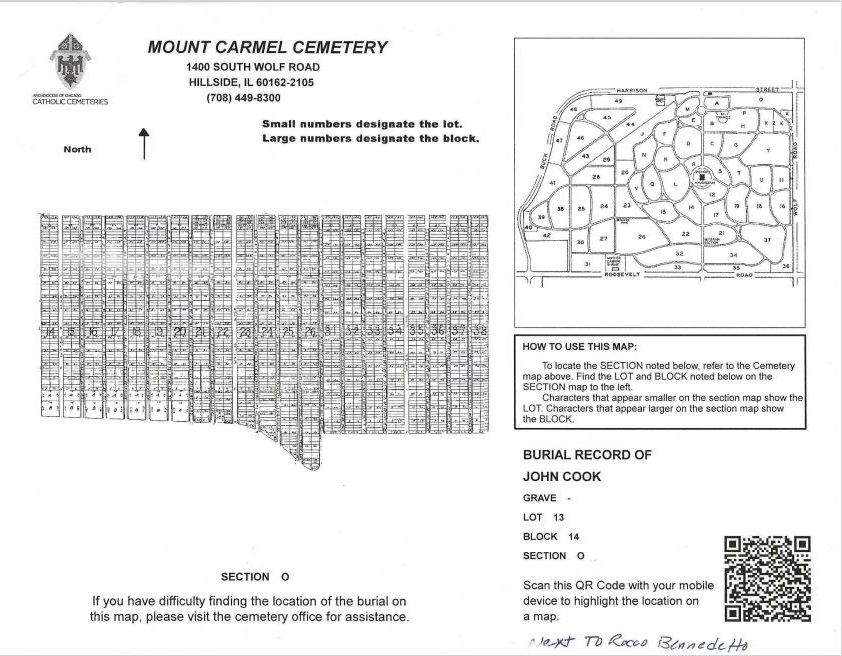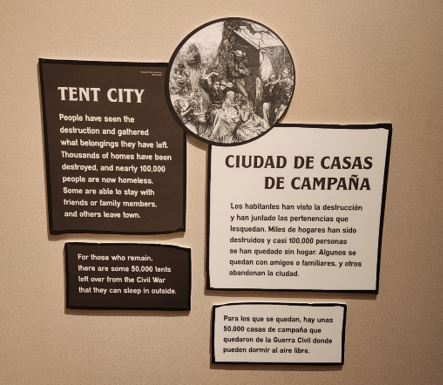
Yes, it is the time of the year to visit cemeteries. Recently while researching in the Chicago area I decided to check out Mt. Carmel Cemetery located in Hillside, Cook, Illinois. Purportedly, my husband’s second great grandparents, John and Mary “Mollie” O’Brien Cook were interred there. No one had made a Findagrave memorial for them so I stopped at the office first to ask for the location of the graves. I was the first one there when the office opened so they weren’t busy. The clerk could not readily find them. I had their birth and death info and various spellings (Cook and Cooke) but she insisted there were too many Mary’s and didn’t find John by his death date. Then it hit me! John had originally been interred in Calvary Cemetery in Evanston when he died in 1894. Some of his children had him moved to Mt. Carmel in 1918. The clerk found him with that burial date that had been entered as his death date. The clerk said she found no one on the record besides John which I found odd as I would have thought his wife, Mary, was buried by him.
I was given the printout you see above. Interesting that there was a QR Code to use to find the stone. Except, it wasn’t. The QR supposedly took you to the cemetery section. I got confused following it on my phone as it wanted to take me out of the cemetery. This turned out to be correct as the cemetery is so large that it continues across a main street. I had entered a different way and did not see that initially.
After 10 minutes and discovering that GPS wanted me to drive across grave stones, I found an alternate route and arrived at the correct section. It was a large section and I wasn’t sure of the alignment because I couldn’t be sure I was facing south. I thought I was and decided to use the compass of my car to double check.
I started at the first row and went up and down and moved on to the next, and so on until I was midway through the section. Something wasn’t right. The Cook family was Scotts Irish. John had been born Protestant in Scotland before emigrating to the US. Mary was born Roman Catholic in Ireland. They met in New York City, eloped in New Jersey and took the train west to Chicago.
My father-in-law loved to say that all of his side were raised Protestant. Except, after his death, I discovered they weren’t.
Molly, according to one of my husband’s aunts, made a deal with her husband John. All boys would be raised Protestant and the girls, Roman Catholic. What no one in the family had discovered (but me!) was that Molly had gotten the boys baptized Roman Catholic, too.
What a gal! Takes a special kind of woman to do that back in the 1850s.
Part of what I was trying to discover in Chicago was which church John belonged to. I wanted to see if they had membership records that included the boys as the family tale states. Haven’t found that yet.
I know the church where Molly had her children baptized, Old St. Mary’s. Her sole daughter, Mary Ellen, married James Hanlon at Old St. Pat’s Church on 26 May 1880. But I digress! Remember the Hanlon name because I’m going back to the cemetery story.
I quickly realized that 95% of the section I was looking at contained Italian names. This could not be right. There was no stone for the Cooks anywhere. The grass hadn’t been cut and I was getting dehydrated and exhausted from bending over flat stones trying to remove dead grass to read the names.
After an hour of this I returned to the office. Quite an interesting experience when I returned. The clerk who had helped me was waiting on someone who was screaming at her that the customer’s mother had been buried in the wrong lot. This conversation was not going well.
Meanwhile, another clerk was helping an older woman and what was likely her daughter understand the cemetery rules. I had other places to go that day so I was impatient but it was nice and cool in the office so I chose to wait.
Eventually, I was called by the second clerk. I showed the paperwork and explained I had walked the section for an hour, knew I was oriented correctly but could not find the grave stone. I explained I had left at 4:45 AM to get to this cemetery, traveling for over 4 hours and I really needed help in locating the graves. I also mentioned that the first clerk insisted that there were too many Mary Cook’s and she couldn’t find the one I needed who had died in 1901.
I’m not sure what magic the second clerk used but he readily told me that Mary was indeed buried next to John, along with several members of the Hanlon family. This explains why John’s body was moved from Calvary. Mary Ellen Cook Hanlon must have wanted her parents buried with her and her husband so John the Protestant, long dead, had no way to object to being moved to a Roman Catholic Cemetery. I’d love to know if Molly ever confessed to him that she had baptized their sons. Something I’ll likely never discover.
Anyway, it turns out the reason I could not find their tombstones is because they don’t have any. Memo to self: Next time ASK IF THERE IS A STONE! This would also explain why the memorials were never created on Findagrave. Whoever transcribed this section of the cemetery without records would not have known they were buried there.
Speaking of records, I also mentioned to the second clerk I would like to get the records corrected since the cemetery had John’s death date wrong. He told me there was no way to correct the records. He also informed me I could not see the original burial records as that was not allowed by the Diocese. Wonderful, not! They have wrong records they won’t correct and family members aren’t allowed to see the records. What a policy of the Roman Catholic Archdiocese of Chicago.
The second clerk, however, kindly told me who the family was buried next to the Cooks. I was able to find that stone quickly and took a pic of the lot to upload to Findagrave.
Here’s reminders for the future: Sometimes you have to ask more than one person at the site to get the full story. Always ask if there is a stone. Allow for more time as the unexpected could throw off your schedule.
I notified family that there was no stone as that was news to me. None seemed interested. If I ever win the lottery I will be spending the winnings on purchasing stones and restoring those that are there. Next week, I’ll be writing about my Swedish dilemmas.




